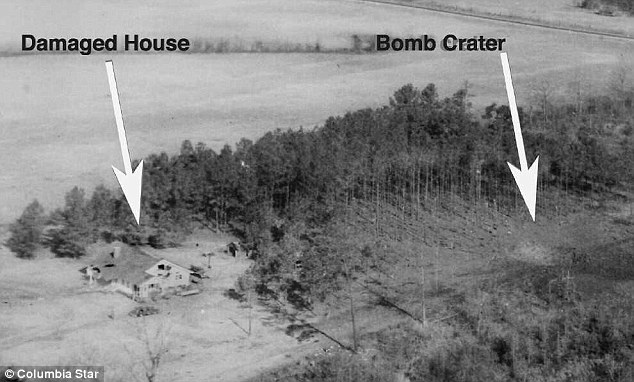– The day a nuclear bomb fell on South Carolina: Extraordinary story of how U.S. air force accidentally dropped weapon of mass destruction onto little girl’s playhouse (Daily Mail , April 27, 2012):
Their awesome power had been harnessed by the Americans ten years earlier to help bring about an end to the Second World War.
But a US Air Force crew nearly wrought similar destruction on its own people after accidentally dropping a nuclear bomb on south Carolina at the height of the Cold War.
But thanks to remarkable good fortune no one was killed in the incident on March 11, 1958.

Shocking: In 1958, the U.S Air Force accidentally dropped a nuclear bomb on a little girls’ playhouse in South Carolina. This aerial photograph taken the day after the bomb dropped showed the damage to the Gregg family home and the impact point

Lucky escape: This image shows how close the bomb landed to the house. it completely destroyed a playhouse but incredibly the family all survived
That afternoon sisters Helen and Frances Gregg, aged six and nine, and their nine-year-old cousin Ella Davies were in the playhouse their father had built for them in the woods behind their house in Mars Bluff, South Carolina.
At around four o’clock they decided to move from the playhouse to the side yard 200 yards away. It was a decision that kept them from becoming the first Americans killed by a nuclear weapon released on U.S. territory.
Minutes later the woods behind the playhouse were destroyed by a nuclear bomb.
The high-explosive trigger in the bomb blew up on contact with the ground, leaving a crater 50 feet across and 35 feet deep.
The girls were all injured but it could have been much worse – all that remained of the playhouse were a few twisted shards of the corrugated metal roof.
As reported by American Heritage, the device had been dropped from an American B-47E bomber that was flying from Savannah, Georgia to England’s Bruntingthorpe Air Base in Leicestershire for routine exercises.
Specifically, it was carrying a Mark 6 30-kiloton fission bomb.
The captain of the bomber, Bruce Kulka, decided to go into the aircraft’s bomb bay to look at the weapon after difficulties during the flight with its locking pin.
But the unfortunate captain had no idea where to find the locking pin in the bomb release mechanism.
He searched for the pin for 12 minutes before rightly realising it was high up in the bomb bay.
He jumped up to see where he thought the locking pin was but unfortunately chose the emergency bomb-release mechanism for his handhold.
The three-ton bomb broke the doors of the plane open and feel towards the earth.
The captain somehow managed to grab onto something and haul himself to safety.
But shortly afterwards, the plane felt the shock of the nuclear bomb hitting the ground.
Luckily, the nuclear core of the bomb had been stored elsewhere on the plane.
But Walter Gregg, 37, was not so lucky.
The 7,600 pound bomb fell adjacent to his home in Mars Bluff, South Carolina.
The blast completely destroyed his vegetable garden and the playhouse of his two daughters and created a massive crater measuring 70-foot-wide and 35-foot-deep.
Remarkably, nobody was killed.
However, six members of Mr Gregg’s family were injured in the blast. The family went on to sue the Air Force and were given $54,000
When the crew of the aircraft returned to their base they were met by armed guards and were all detained. The Air Force initially suspected the bombing was an act of sabotage but they managed to tell their story and eventually avoided reprimand.
The bombing crew also went on to apologise to the Gregg family.
If one accidental dropping of a nuclear weapon on its own soil wasn’t enough, the Air Force managed to do it again just a few years later.
It happened on midnight on January 24, 1961, over Goldsboro, North Carolina.
A B-52G bomber broke up when the crew onboard noticed a leak during mid-air refueling.
The wreckage of the aircraft fell over the town of Faro and five of the eight-strong crew managed to survive.
But this was the least of the worries of the Air Force.
The aircraft was carrying two Mark 39 thermonuclear weapons. One of them gently parachuted to the earth.
But the other flew into a farmers field at 700 miles per hour. The force of the impact led to it losing its uranium.
Unlike the first incident, three years earlier, this crash could have had terrible consequences.
As reported by 109.com, the deactivator of the bombs, Dr. Jack Revelle admitted, ‘How close was it to exploding? My opinion is damn close.’
The then secretary of defense Robert McNamara, admitted that when the bomb was found its arming mechanism had gone through every step but one of the seven stages of detonation.
More worrying, it later emerged that the bomb had broken into several pieces, including one which was never found.
This missing piece contained uranium and its believed to have sank deep into the earth.
Since then, and perhaps sensibly, the Air Force purchased the land.
Both incidents highlight how lady-luck stepping in managed to prevent lives being lost and highlight the anxiety surrounding nuclear bombs.